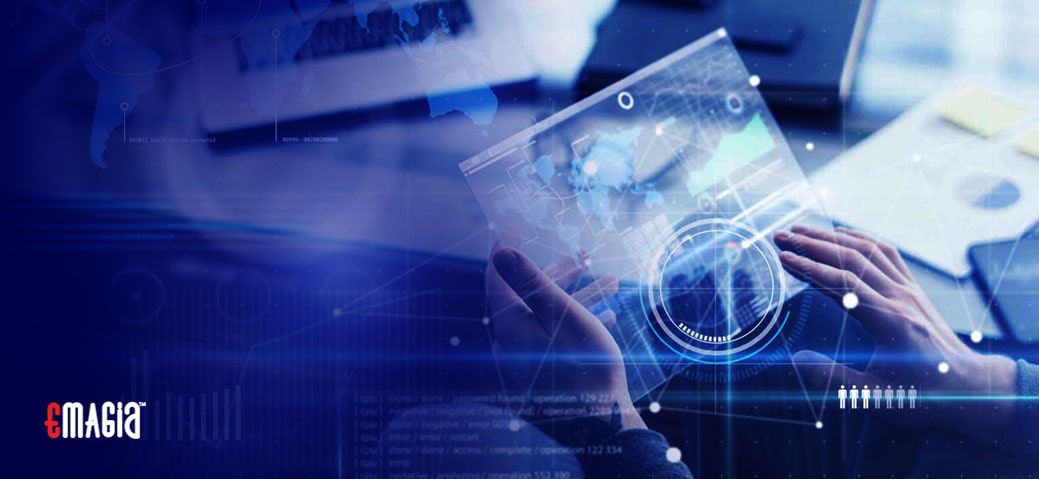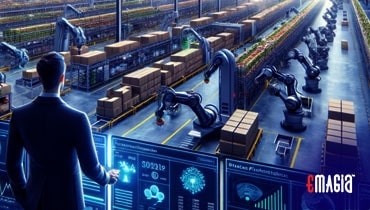Emagia Staff
30 April, 2024

Autonomous finance goes beyond simple automation. It not only automates finance tasks but also delivers accelerated real-time insights, predictive analytics, seamless compliance, and greater resilience in financial strategy.
Autonomous finance is an algorithm-driven financial operating model that uses self-learning software to automate corporate finance operations. In this environment, finance processes are partly governed by automation technologies like artificial intelligence, optimizing front-, middle-, and back-office finance operations. It includes various automated finance processes such as accounts receivable (AR) and accounts payable (AP), with features like automatic customer invoicing and invoice approvals.
Managing processes like the order-to-cash (OTC) cycle through autonomous systems can improve efficiency, save time, and reduce errors. Automated customer billing, receivable collection, and payment applications provide real-time data, while autonomous accounts receivable platforms streamline workflows, enhance cash flow, and offer more accurate insights for decision-making with minimal human intervention. Automated customer billing systems can automatically create, approve, and submit invoices, and offer access to key performance indicators (KPIs).
Understanding Autonomous Finance
Autonomous finance leverages advanced technologies such as machine learning (ML), artificial intelligence (AI), robotic process automation (RPA), and advanced analytics to automate business financial processes. Gartner reports that 64% of CFOs expect their finance functions to be autonomous or mostly automated within the next few years, driven by automation of accounting, financial processes, and analytics for real-time and predictive insights.
Now, automation and autonomy are not the same. Automation handles repetitive, time-consuming tasks that are prone to human error, freeing up humans for higher-level activities. Autonomous systems, however, learn and adapt to changing environments, evolving with the data they collect. They continuously ingest and analyze data sets, learning from them in ways that would be challenging for a human.
Autonomous Order-To-Cash (OTC) Process
The OTC process involves several functions, such as credit approval, customer relations, order management, invoicing, and monitoring customer payment trends. Automated accounts receivable (AR), a core part of the OTC process, starts with credit management and extends to automated invoicing. This involves extracting information from platforms like ERP to generate error-free invoices instantly, helping avoid payment delays and ensuring seamless reconciliation.
Automated invoicing converts sales orders into electronic invoices once orders are fulfilled or services are delivered according to contractual billing terms. This process helps ensure customers receive invoices quickly, and the AR platform can then match customer payments to open invoices, analyzing customer behaviors and payment trends. This system allows receivable teams to manage operations more efficiently, enabling leaders to oversee processes at scale with dashboards and interactive reports.
How Does an Automated Customer Billing System Work?
An automated billing system automates core accounts receivable tasks like invoicing and payment collection, replacing manual methods such as paper invoices and manual data entry. These systems are ideal for mid-to-large-sized organizations seeking to manage large volumes of customer invoicing and complex billing structures. Automated workflows streamline the billing cycle, boosting efficiency, accuracy, and speed.
The workflow begins with the customer invoicing system collecting data like customer master information, billing parameters, and transaction records from an integrated ERP or direct user inputs. The system automatically creates invoice records, applying the configured billing terms or pricing structures. Once approved, the invoice is digitally transmitted to the customer and recorded into the ERP system as a receivable. Payments are processed electronically through the company’s preferred method.
Automated processes reduce risks of errors and invoice delivery delays often associated with manual billing. The integrated AR system tracks invoice statuses in real-time, providing the finance team with insights into expected payment timelines and outstanding balances. This enables more accurate cash flow forecasting and management, giving businesses a competitive edge in today’s dynamic marketplace.
How Automated Billing Empowers Autonomous Finance
Automated billing, a key component of the OTC process, is crucial for autonomous finance. It streamlines the billing process, minimizes errors, and enhances efficiency. Here are some of the benefits of automated billing in empowering autonomous finance:
- Enhanced Efficiency: Automated billing eliminates the need for manual tasks such as generating and delivering invoices, saving time and money. The system automatically creates invoices based on predefined criteria, reducing the costs associated with manual billing processes.
- Improved Accuracy: Automation reduces errors common in manual processes. Incorrect entry of customer and order information can lead to invoicing mistakes, revenue leakage, and payment delays. Automated billing minimizes these risks by automating data entry and validation.
- Streamlined Collection: Automated billing systems offer secure online payment options, reducing the need for manual check processing and minimizing the risk of fraudulent attacks on customer accounts.
- Financial Insights: Automated billing systems provide detailed insights into financial performance, especially regarding receivables and cash flow, allowing businesses to make informed decisions. Real-time analytics aid in more effective financial management.
- Improved Scalability: Automated billing systems facilitate scalability, allowing businesses to experiment with different business and pricing models. This flexibility helps companies adapt to changing market conditions and customer demands.
Summing Up
Technology has transformed the accounts receivable (AR) process, especially with the emergence of autonomous, data-driven, cloud-based OTC platforms. These platforms enable businesses to automate customer communications, addressing the challenges of manual invoicing and payment. A McKinsey & Company study concluded that 45% of activities in many industries can be automated with current technologies.
Veena Gundavelli, founder and CEO of Emagia, a provider of AI-powered OTC and AR solutions, remarked in a recent PYMNTS interview: “Generative AI is transforming various industries by improving efficiencies, and some of the most promising applications are within finance operations and accounting workflows.”
FAQs
What is the Role of Artificial Intelligence and Machine Learning?
Artificial intelligence and machine learning are central to autonomous finance, allowing systems to process and analyze large volumes of data. These technologies facilitate personalized financial insights and recommendations, helping users make informed decisions. Machine learning plays a crucial role by continuously learning from data, identifying patterns, and predicting trends. By adapting to user behavior and market conditions, AI/ML can offer real-time recommendations, helping fine-tune financial plans.
What is the Difference Between Automation and Autonomous?
While automation and autonomous might seem similar, the critical distinction is intelligence. Automated systems handle routine tasks based on predefined criteria. Users set rules, and the system takes action accordingly. If something falls outside these parameters, a human must intervene. Autonomous systems, on the other hand, have intelligence and can act independently, learning and adapting to changing situations. They can identify and respond to new data without user-defined rules, reducing the need for human oversight.






